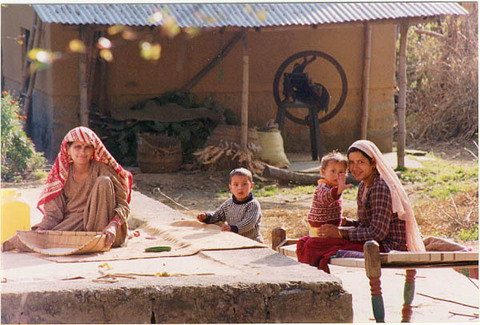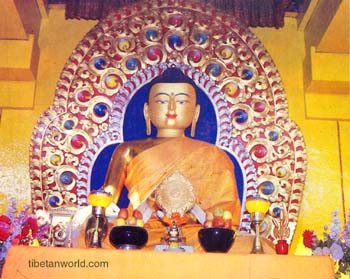|
 On the surface
everything seems fine with the socio - economic change in the
Dhauladhar foothills disorderly though it may be- for it has
promoted tourism, generated a little employment and strengthened
Hill’s economy, but at times one gets the feeling that modem life
isn't that a hill-culture is designed for,And it isn't. The
green psyche of the man from high hills, his love for Nature, his'
respect for life forms (from herds to herbs): his sensibilities,
Image by P r Bali his
lifestyle, his needs, his beliefs, his emotions evolved in the lap
of Nature ,.. in a holistic environment. So the modern 'cultivated'
environment, for all its comforts, can be the most- if one may use
the word-"disquieting" for him. ' On the surface
everything seems fine with the socio - economic change in the
Dhauladhar foothills disorderly though it may be- for it has
promoted tourism, generated a little employment and strengthened
Hill’s economy, but at times one gets the feeling that modem life
isn't that a hill-culture is designed for,And it isn't. The
green psyche of the man from high hills, his love for Nature, his'
respect for life forms (from herds to herbs): his sensibilities,
Image by P r Bali his
lifestyle, his needs, his beliefs, his emotions evolved in the lap
of Nature ,.. in a holistic environment. So the modern 'cultivated'
environment, for all its comforts, can be the most- if one may use
the word-"disquieting" for him. '
In three decades and a
half with 'DHARAMSHALA' appearing prominently on the Buddhist
pilgrimage-map, the culture-contacts of the natives have multiplied
from occasional interactions to prolonged exposures of diverse
Kinds. And, The hill habitations of Mcleodganj, Dharamkot, Naddi,
Bhagsu and Talnu overlooking the expansive Kangra valley, have
emerged as centers where the nomadic tribe of “Gaddis” has come in
intimate contact with alien entities – Mongoloids, Europeans, Aryan-
Mongoloid Jewish and others. And the contact phenomenon that follows
the opening up of ‘closed’ cultures.
For the first-timer,
it may not be evident, but any old-timer can sense the silent
cultural transformation which' is relatively recent in origin. Talk
to the elderly residents in Dharamkot and they admit the fact:
"Modem airs are sweeping the hill environs and the typical tribal
flavor may vanish with a few more generations", says Paras Ram, a
Gaddi selling cakes, Danish buns, mineral water, sesame oil , brown
rice, honey and coffee in Dharamkot. Some of the notices pasted onto
the walls of his small shop read: "Join Yoga classes"; "Courses on
Indian classical music";" Zed meditation courses “;" Vipassana
courses”; " Contact for body massage”; " Learn martial arts"; "Learn
Hindi";. A guitar session around campfire" etc... And the first
signboard that welcomes you to McLeodganj warns: "AI DS - It can
happen to you". Do they really mean it... that too in a pilgrim
center?
"Much has changed in
the name of development, but something' is amiss now", admits
fifty-year-old KhIooni Ram who has come from Sallie village, seeking
work as a construction labourer in one of the hotels, lodges,
villas, or meditation centers which have come up fast in the area.
He reminisces clean and green McLeodganj, which once had thick
forests of oaks and deodars resonating with the Magpie's calls.
Rhodes bloomed in abundance. Such was the meditative quality of the
place then, he says. Today, public roads disturb the orderliness of
the jungle habitat. And the inhabitants are getting increasingly
incompatible with the shrinking habitat.
What strikes one most
is the fact that the ‘older folks’ of the tribe stand contented at
the very center of their “ Bharmarui culture “ while the ‘new age’
folks seem confused by the obvious mismatch between the ancient and
the modern-popping bubble gums, marrying foreigners and Imbibing
every bit of all pervasive discontent. It’s they who face a
veritable Hobson’s choice: between the eco-cultural pulls and the
pressures of adept ion. It's they who get increasingly indecisive as
more and more 'nomads' turn settlers, looking for unconventional
occupations. Will they head home or drift away? Can’t say for sure.
It's the 'gray ideas'
Perhaps that guides
green cultures on Darwinian lines, so one believes; leaving the rest
for the sociologists or ethnologists to examine their acceptance and
inhibition, their reaction and resilience to the profound
disturbance of modernism.
"But who can insulate
a him-culture from the evolving vastness?" asks Negi a local
porter-mountaineer who has pottered countless expeditions across the
Dhauladhar in 20 yrs. of trekking. "No one can and one should not,"
answers' a fellow mountaineer, Pram Sager from Eagle's Height
Trekkers, elaborating Negi's point. '"Adaptation-not isolation-will
forever remain the mainstay of both biological and cultural
evolution," he says.
True that is. As a
silent onlooker, one who has seen the poverty and illiteracy of a
score of giddy? Habitations – Both, Sally, Darini, Bangotu, Ghera,
Kareri, chola – Surrounding the culture-contact centers can say with
concern that the typical flavor of theirs will fill the outer
Himalayan airs for a half of century more, If they do not come out
of the self-imposed isolation, outgrow their infancy and learn to
century more, if they do not come out of the self – imposed
isolation with the ‘rational’. They have countless Historical
parallels to emulate that, within the confines of traditionalism,
conceived remarkable ideas, created an inspiring culture of
survivors and carved a niche for them in the big wide world. Also,
if interdependence of all beings and adaptive quality of cultures
are vital evolutionary processes, an ethnic
entity -any entity for
that matter - must choose the 'adaptive traits' and drop the
'uninvolved ones' for its survival.
But then, which
cultural traits can the Gaddis shed and pick from or contribute to
the 'pool-of-cultures' to maintain a dynamic Inter-flow with the
alien ethnic entities and be on the path of much-needed progress
like the contemporary kind That's the question one should ask: "Is
it the wisdom of rusticity or ignorance of ethnic pride? The
emotional maturity of ethnicity or self-imposed infancy ? The
rational element of beliefs or shoddiness? The flexibility of the
culture or its rock-solid rigidity? . Or perhaps it could be the
aesthetics. of a culture steeped in poverty?" There can be many to
choose from and many more to shed. But the ones they choose now will
make the culture-contacts a phenomenon of co-existence, a 'Vasudhaiva
Kutumbakam’. . Or an outright cultural harakiri.
So, a hill-habitation-
nay any ethnic entity - is constrained to set the broad contours of
its evolutionary course which, I' m afraid, is not an easy task.
Because evolution in itself is a journey in space and time to the
unknown is unending and unpredictable. With each step, one runs the
risks of losing identities-ethno-religious, cultural and others.
Therefore, some
genuine fears haunt the hill habitations- fears that a consumerist
society generates; and concerns that a rustic society, harbors in
meeting industrial cultures. " The contaminating contact of
modernity may thwart the virtues that rusticity holds scared and
holy that haunts us most", says this old shepherd pacing uphill with
a flock. He rests a. load on his back against the wayside rock;
wipes his
sweat-dripping face and continues the argument: " The virtues that
we treasure for generations -simplicity , honesty ,warm-heartedness
, compassion ,truthfulness and nature’s lifestyles-are the traits of
a mature and spiritually uplifted culture. Aren't these ?' He looks
for no answer and moves on, but the question still echoes In my
mind.
Of course, these are
the traits that sustain "life" on earth. These are the traits that
set the hill community apart as the piously humble, the scriptural
'meek’ who shall inherit the earth! But
hollow consolations
these are. So the fears multiply.
As the struggle for
survival sheds the archaic ways and acquires 'new age' dimensions,
even a casual conversation with the natives - literate or
illiterate- reveals a painful awareness of the immense loss : " In
an ethnic meltdown, cultural identity has only economic
interpretations ", rationalizes a worried social activist, Pram
sager. Another activist, Nanak Chine reciprocates the concern: "The
modern scheming mind and its avaricious economics is devising ways
to teach 'new' survival strategies which may not suit the hill
tribe. The local market place is replete with instances of 'dealers'
who, in the name of eco-cultural preservation, put to sale the hill
ecology and the culture based on it.. Apart from holding
eco-cultural shows they regularly bring out heaps of glossy
publications in Mecleodganj which never reveal’ the truth about the
rampant eco cultural degradation here. Who profits from it? The
scheming mind, who else? It is amazing that the so Called
eco-cultural enthusiasts wink at the goings on and never expose the
ecological hypocrisy of this kind," he sounds ruthlessly harsh.
And, his observations
are based on truth. Look, vvhat the Bharmauri culture' has been
losing over the years’: the folk arts and and aesthetics ;the
discarded deities; the flora and .. Fauna; the tribal lands and
herds; the herbs and the healing system-- all dirt-cheap, their
traditional respect for the heritage Is gradually turninginto a mad
zeal for prosperlty, they are in for an "eco-cultural shock EhI the
green psyche Is turning grey In search of an' elusive
prosperity I.
Then, there are those
who argue: "No matter how good and contented a hill-culture may
seem. The inhabitants of the high hills cannot be denied the
opportunity to enjoy the benefits and comforts of the modem
development. "Convincing that is . But this argument is not made
with an agonising honesty and it carries some serious errors of
thinking. Do we need someone to tell us that the economics of new
age is devouring the old -world's economics of survival? So, one has
reason to take up the cause seriously. True humanism demands that
tribal realities should not be viewed as tradable commodities to
meet the insatiable urban economic needs. What is good for survival
has to be good for economics too - not the other way round |


 On the surface
everything seems fine with the socio - economic change in the
Dhauladhar foothills disorderly though it may be- for it has
promoted tourism, generated a little employment and strengthened
Hill’s economy, but at times one gets the feeling that modem life
isn't that a hill-culture is designed for,And it isn't. The
green psyche of the man from high hills, his love for Nature, his'
respect for life forms (from herds to herbs): his sensibilities,
Image by P r Bali his
lifestyle, his needs, his beliefs, his emotions evolved in the lap
of Nature ,.. in a holistic environment. So the modern 'cultivated'
environment, for all its comforts, can be the most- if one may use
the word-"disquieting" for him. '
On the surface
everything seems fine with the socio - economic change in the
Dhauladhar foothills disorderly though it may be- for it has
promoted tourism, generated a little employment and strengthened
Hill’s economy, but at times one gets the feeling that modem life
isn't that a hill-culture is designed for,And it isn't. The
green psyche of the man from high hills, his love for Nature, his'
respect for life forms (from herds to herbs): his sensibilities,
Image by P r Bali his
lifestyle, his needs, his beliefs, his emotions evolved in the lap
of Nature ,.. in a holistic environment. So the modern 'cultivated'
environment, for all its comforts, can be the most- if one may use
the word-"disquieting" for him. '